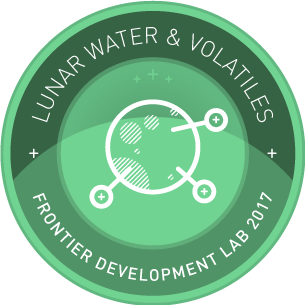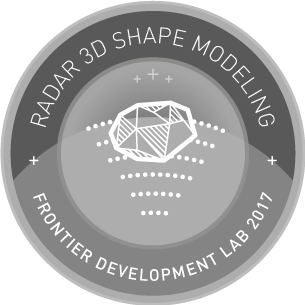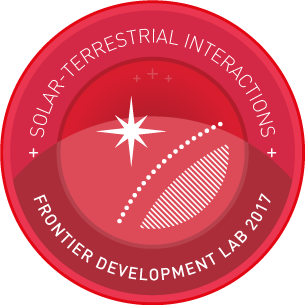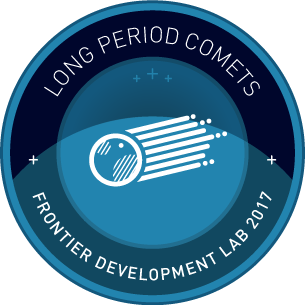
FDL 2017
FDL.AI 2.0 was increased to eight weeks. Five teams studied solar storm prediction, solar terrestrial interactions, lunar water and volatiles, long period comets, and asteroid shape modeling.
Navigate to research area
LUNAR WATER & VOLATILES CHALLENGE
AUTOMATION OF THE PRODUCTION OF CRATER MAPS OF THE LUNAR POLES - VITAL FOR PROSPECTING THESE WATER-RICH REGION
A large dataset was compiled for the Lunar south polar region and high-level feature extraction focusing on crater detection was performed. Results showed an impressive speedup of 100x compared to human experts, with more than 98.4% success rate.
RADAR 3D SHAPE MODELING CHALLENGE
CONTINUING THE WORK FROM 2016, THE TEAM APPLIED AI TECHNIQUES ALONG THE SHAPE MODELING WORKFLOW
Asteroid shape modeling currently takes up to four weeks of manual interventions by experts using established software. The team demonstrated a pipeline for automation, optimizing the Neural Nets and utilizing GANs, that allows NEOs to be modeled in several hours.
-
-
Applications of Machine Learning to Asteroid Shape Modeling
Researchers: Agata Rożek, Grace C. Young, Adam Cobb, Sean Marshall
Mentors: Michael Busch, Chedy Raissi, Yarin Gal" -
Machine learning tools to produce 3D shape models of asteroids from radar observations - BIB
Busch, M. Rożek, A. Marshall, S,.Young, G. C. Cobb, A. D. Raïssi, C,.Gal, Y. Benner L. Taylor, P. A, Lowry, S.
Using Bayesian Optimization to Find Asteroids' Pole Directions - BIB
Authors: Rożek, Agata; Busch, Michael W.; Marshall, Sean E.; Young, Grace C.; Cobb, Adam D.; Raïssi, Chedy; Gal, Yarin; Benner, Lance A. M.; Taylor, Patrick A.; Lowry, Stephen C.
-
American Astronomical Society, DPS meeting #50 2018 - Using Bayesian Optimization to Find Asteroids' Pole Directions
Authors: Rożek, Agata; Busch, Michael W.; Marshall, Sean E.; Young, Grace C.; Cobb, Adam D.; Raïssi, Chedy; Gal, Yarin; Benner, Lance A. M.; Taylor, Patrick A.; Lowry, Stephen C.
EPSC-DPS Joint Meeting 2019 - Machine learning tools to develop 3D shape models of near Earth asteroids from radar observations
Authors: Rożek, Agata; Busch, Michael W.; Marshall, Sean E.; Young, Grace C.; Cobb, Adam D.; Raïssi, Chedy; Gal, Yarin; Benner, Lance A. M.; Taylor, Patrick A.; Lowry, Stephen C.
-
SOLAR STORM PREDICTION CHALLENGE
THE APPLICATION OF AI TO DETECT SOLAR FLARES AND BETTER UNDERSTAND THE SALIENCE OF SOLAR ACTIVITY AND SPACE WEATHER - CRUCIAL FOR FUTURE HUMAN SPACEFLIGHT MISSIONS
The FDL.AI team performed analysis of solar magnetic complexity and deployed multiple CNNs to connect solar UV images (Solar Dynamics Observatory / Atmospheric Imaging Assembly) into forecasts of maximum x-ray emissions. The work suggests there is potential to improve the reliability and accuracy of solar flare predictions.
-
-
FlareNet: A Deep Learning Framework for Solar Phenomena Prediction
Researchers: Dattaraj Dhuri, Anamaria Berea, Sean McGregor
Mentors: Andres Munoz, Ryan McGranaghan, Troy Hernandez"
SOLAR-TERRESTRIAL INTERACTIONS CHALLENGE
DEMONSTRATION OF AI AS A TOOL FOR SCIENTIFIC BREAKTHROUGH, VIA ‘DISCOVERY’ OF THE (PREVIOUSLY KNOWN) EQUATORIAL RING CURRENTS OF EARTH’S MAGNETOSPHERE
The FDL.AI team built a knowledge discovery module named STING (Solar Terrestrial Interactions Neural Network Generator) on top of industry-standard, open source machine learning frameworks to allow researchers to further explore these complex datasets.
LONG PERIOD COMETS CHALLENGE
DISCOVERY OF UNCATEGORIZED METEOR SHOWERS, WHICH MAY SUGGEST THE PRESENCE OF LONGPERIOD COMETS THAT CROSS THE ORBIT OF EARTH ON MILLENNIAL TIME SCALES
The FDL.AI team showed how the data reduction of the ‘CAMS’ (Cameras for Allsky Meteor Surveillance) meteor shower survey program could be successfully automated. By using dimensionality reduction (t-SNEs) the team were able to identify yet to be catalogued meteor shower clusters.
-
-
Searching for Long-Period Comets with Deep Learning Tools
Researchers: Antoni Ordoñez, Marcelo De Cicco, Susana Zoghbi, Andres C. Plata Stapper
Mentors: Peter Jenniskens, Siddha Ganju, Peter Gural, Yarin Gal, J.L. Galache" -
Planetary and Space Science Journal 2018 - The Deflector Selector: A machine learning framework for prioritizing hazardous object deflection technology development - DOI
Authors: E.R. Nesvold, A. Greenberg, N. Erasmus, E. van Heerden, J.L. Galache, E. Dahlstrom, F. Marchis
Planetary and Space Science Journal 2018 - A survey of southern hemisphere meteor showers - DOI
Authors: Peter Jenniskens, Jack Baggaley, Ian Crumpton, Peter Aldous, Petr Pokorny Diego Janches, Peter S. Gural, Dave Samuels, Jim Albers, Andreas Howell, Carl Johannink, Martin Breukers, Mohammad Odeh, Nicholas Moskovitz, Jack Collison, Siddha Ganju
ArXiv - The Deflector Selector: A Machine Learning Framework for Prioritizing Hazardous Object Deflection Technology Development - DOI
Authors: E.R. Nesvold, A. Greenberg, N. Erasmus, E. van Heerden, J.L. Galache, E. Dahlstrom, F. Marchis
-
International Meteor Conference 2017 - New developments in meteor processing algorithms



























